Fruit flies in kombucha…they’re not a match! Here’s how to keep those pesky fruit flies away from your kombucha projects (and what to do if they get inside).
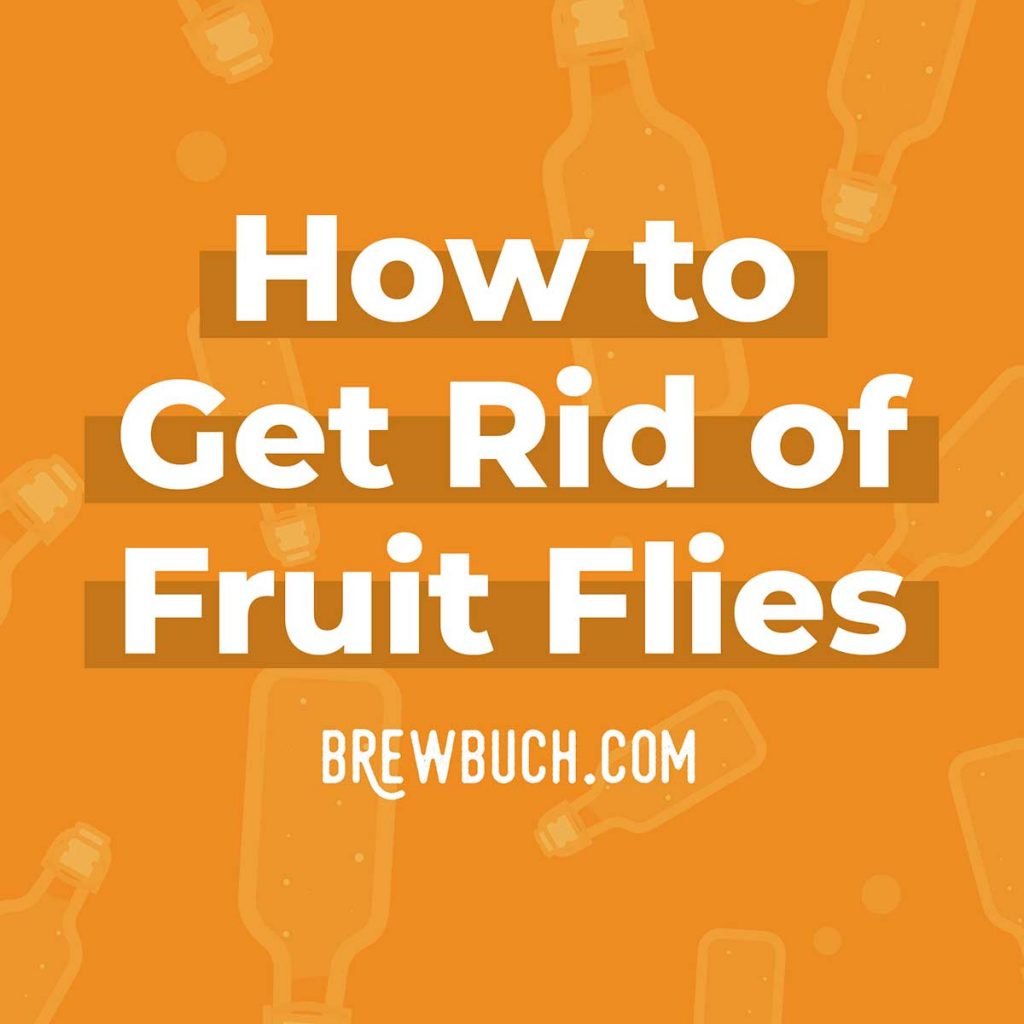
You may have noticed that fruit flies seem to be attracted to kombucha (maybe even more so than we are!). They’re attracted to the smell of fermentations (like rotting fruit, garbage, and of course kombucha), so you may find them hovering on top of your first fermentation jar.
Is it okay for fruit flies to be sitting on top of your jar? Yes. But is it okay for them to be inside your jar? Nooo.
So if you’ve noticed a few (or many ????????♀️) fruit flies hanging around your kitchen, you’ll need to take some precautions to make sure they don’t slip into your kombucha.
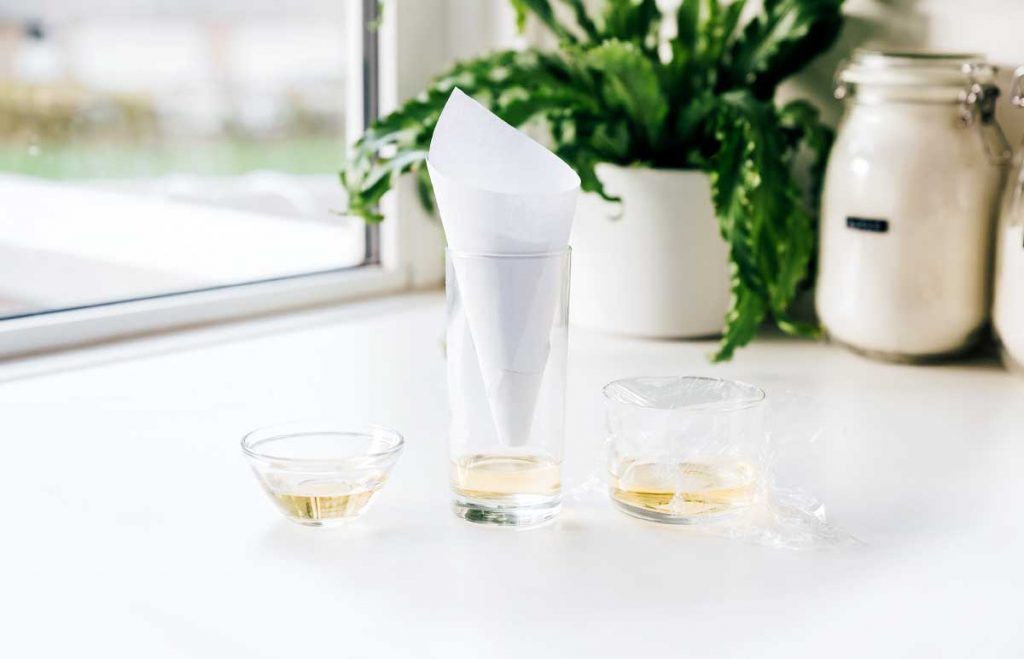
Reduce the number of fruit flies
The first step in keeping fruit flies out of your kombucha is to reduce the total number of fruit flies as much as possible. Make a few fruit fly traps and nestle them around your kitchen. These will attract and kill the fruit flies. Here are three fruit fly traps that work well for us:
Funnel over vinegar (or kombucha): Add a bit of vinegar, kombucha, or even some rotting fruit to a tall glass. Set a funnel over the glass. The flies will be attracted into the glass, but won’t know how to get out.
Vinegar (or kombucha) + dish soap: Add vinegar to a small dish, then add a drop of dish soap. The soap will reduce the surface tension so the flies sink (a sad way to go, but sometime’s you gotta do what you gotta do for your brew).
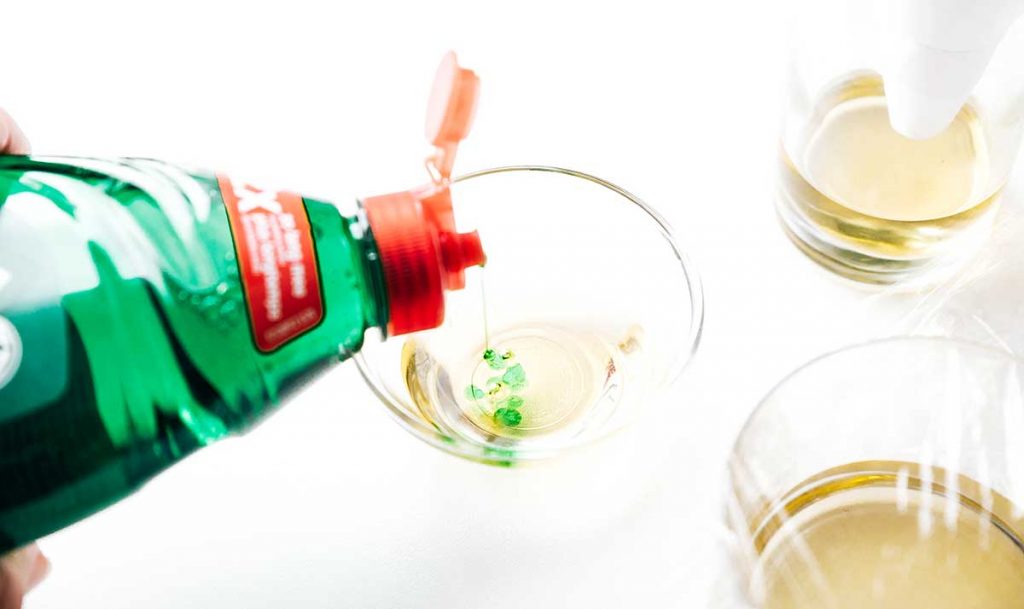
Plastic covered cup: Pour your smelly substance into a glass, then cover it with plastic wrap. Prick holes in the top with a fork so the flies can get in (they won’t be able to find their way back out).

Store bought fly traps: While these homemade traps all work well, I’ve also had success by hanging a sticky strip next to our kombucha vessel.
Keep flies out while brewing
While your kombucha brews, the number one thing you can do to protect it from fruit flies is to ensure it is covered with a proper cloth.
While cheesecloth is the conventional recommendation, some cheesecloths are not finely woven and can leave gaps for fruit flies to sneak in. To prevent these sneaky buggers, use one of these as the cloth covering for your first fermentation:
- Tightly woven cheesecloth, folded over itself a few times
- Coffee filter
- Few layers of paper towels
- Tea towel
- Cotton t-shirt
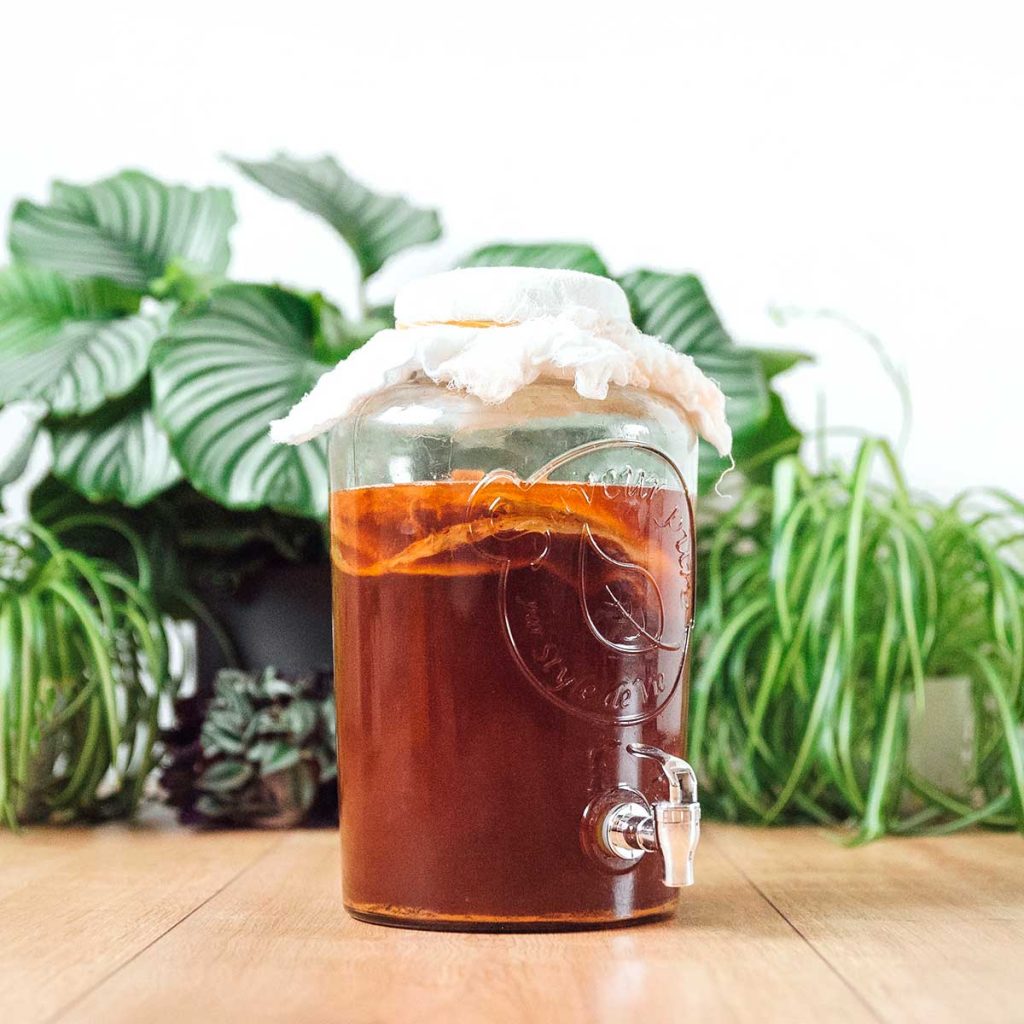
Keep flies out while bottling
So what if you need to bottle your kombucha and there are kombucha-thirsty flies hovering everywhere? Here are a few tricks I use nearly every time I bottle.
Work quickly: If there are just a few flies, simply work quickly. Take off your cloth covering, pour the kombucha into a ready-to-go jug or bottles, then quickly replace the cloth covering. I typically don’t let my vessel be exposed to open air for longer than 20 seconds (trust issues, much?).
Use a fan: Point a fan at your work space. The fruit flies won’t be able to fly through the strong wind (i.e. your wind shield ⚡️).
Vacuum: If there are many flies sitting on top of your brew, use the hose attachment of your vacuum and suck up all the flies around your brew.
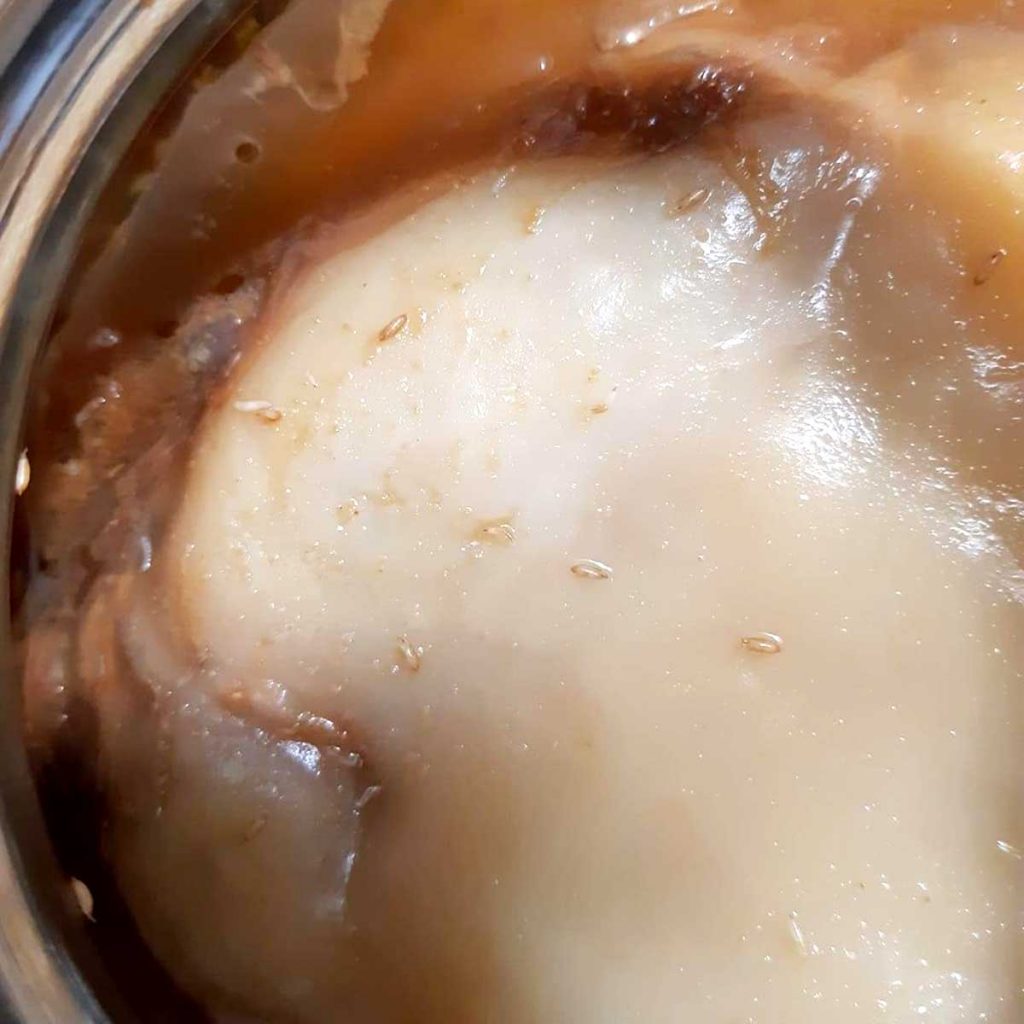

Fruit flies got in my kombucha! Now what?
You opened the top of your first fermentation and noticed a dreaded fruit fly inside. Now what? Well there are two camps of people on this: the squeamish and the brave.
Let’s start with the squeamish. I fall squarely into the squeamish category (especially after having seen a video sent to me from a reader of a fruit fly maggot in her kombucha). For people like us, just throw it all away. The fly may have laid larvae, and you’ll never be able to get the thought of maggots out of your head. Just accept, toss it out, clean your supplies, and move on.
For the brave, you can salvage your kombucha. If your SCOBY is fairly large (more than an inch), it is unlikely that the fruit fly was able to penetrate very deep into the kombucha. Carefully remove the SCOBY and peel off the top layer. Rinse the bottom layer very well then add it back into your vessel.
After a week, exam the brew well for any traces of larvae. If you still see traces of an infestation, throw it all away. But if you don’t see anything, you should be fly free!
Annnnd now that I’ve thoroughly infiltrated my brain with images of fruit flies and maggots, I’m going to go look at pictures of kittens. Happy brewing!

Hi.
I had to get rid of quite a thick scoby bc I was squeamish about the larvae that I’d found in it. I did however keep the bottom layers–but what do I keep the scoby in while I’m waiting for the week or so to see if there are any eggs/larvae?
Thanks a lot,
Riaz
Just keep it in some already-made kombucha! 😀
Hello,I found maggots on the inside of the kombucha jar but they haven’t gone into the kombucha tea. it’s just 1 maggot. I kept wiping around the jar if there were fruit flies eggs but I forgot to look if there were eggs on the surface of the scoby. Can I wait another 3 days and if there are no maggots, I use a coffee filter to filter and proceed to the second fermentation?
I think that would be okay! I mention it in the article, but with this it really just depends on you (if you’re too grossed out by the thought of it or not). I’m with you, save the buch!
I like to use old handkerchiefs to cover the jar…they are a nice size. I use one in the winter (non-fruit fly months) and two in the summer, plus I use 2 large rubber bands in the summer as I found some fruit flies got in with only one rubber band!
I left my SCOBY over winter and didn’t check on it until today, noticing what appeared to be one larva in it. I was wrong -there were around 30 larvae. I separated some of the layers that were badly infested, and used a pair of tweezers aided by a magnifying glass, to identify and pick out the larvae. I rinsed it, washed out the original vessel really well and put it back together. Wish me luck! Also experimenting with bits of the SCOBY not infected and seeing if I can grow it from small pieces.
I am trying nylons. I was using cheese cloth and learned that it is was not dense enough for the recent fruit fly visit. I tossed the batch and will rinse the SCOBY. Hopefully, I remember to report back. My SCOBY might be a little thin, now, but I think it will be alright.
Ugh.. fruit fly maggots and larvae on my buch.
Strain and drained whole thing into doubled coffee filter.
What to Do? Boil the booch and add my cleaned Scooby back to it?
I think that would work well! You can even rinse off the SCOBY under water or vinegar to be extra sure it’s clean.
I had mine poured in a tall can and was excited to try it. And well I left the can unattended for maybe an hour. Thought I had it under control though, I put a thick piece of paper folded twice on top of my can however when I went to remove my weak cover and give it another taste there were TWO fruit flys just on the top part of the can, instantly flew out and past me, not sure how long they’ve been there and I’ve had them lay eggs around the lip on previous batches. So idk what to do now but filter it with a cloth and bottle it for a few days just to see if I notice any pests in my brew then? My biggest fear is the little devil’s to be so small I wouldn’t be able to see them. Please feel free to email me more in depth details on fruit fly larvae and perhaps what y’all did or would do in this situation. I’m more than likely gonna drink it and feel disgusting too but ya know. Probably have all consumed larvae at least once I guess..
Ps. I didn’t know they laid maggots in beer and drinks for a long time and now this has got me anxiously thinking back to when I drank half empty beers cans or bottles the next morning or even longer omg… back in the day, and I know I’ve had to consume many squirmies at one point. Wish I knew that they enjoy alcohol just as much as we do back then..
I’m definitely BRAVE…I had some of those little pesky buggers in one of my batches, and I just picked them out with a clean hand, covered it up with 2 layers of cheesecloth this time, waited a few more days and checked it again…there was no sign of any, so I bottled it, flavored it…and then a day later I drank it!! I’m fine, and so is my booch????????
I’m glad you’re brave! I was devastated to find the adults and the larvae in a newly separated SCOBY that I made into a larger batch! I’m going to try rinsing and leaving it to check it later. Will update.
i got up this morning on 2nd day of making it and found a small fly hoovering above, found some great ideas here have covered with a 2nd cloth and have a fan on it plus made the mixture up of vinegar and soap liquid in a small covered bowl with film wrap and holes, fingers crossed….. any other amazing ideas that i can to prevent entry!!!
Ok so I’m on the brave side in this case, here’s my scenario…
At the end of my most recent first fermentation there was about 10 little squirmies on top of my scoby. The scoby is a solid inch thick. While removing it a few fell into my batch, I sucked them out with a turkey baster, nbd. (Ok yeah pretty gross but they were only in there for a few seconds). My question is… is it SAFE to go ahead with the 2nd fermentation or should I dump the whole batch??
Hi Mike! It’s so hard to say, but if you’re not squeamish then it should be safe to drink. But if you’re at all worried just start a new batch!
Ugh! I don’t know if I will ever get the vision of those fruit flies in my kombucha SCOBY out of my head!!! Thank you for being firmly in the squeamish category – I am brave in many parts of my life, but NOT this one. GROSS, GROSS, GROSS! Luckily, I do know how to start a new SCOBY from the batch of kombucha I have in my fridge and there is another one waiting in a hotel… Thanks for the ideas about good covers. I had a loose cheesecloth on the batch that got infested (gag.. gag again… gag) and it worked for a long time, never had a fruit fly infestation. Now I know.
I ended up with larvae inside when I used a tea towel. I tossed everything. Thankfully I had a second SCOBY waiting to do it’s job so I started over this time using a coffee filter. Since I was also using a jar with a spigot I also super cleaned it and wrapped a piece of paper towel over the spigot just in case. Maybe over kill but it worked beautifully.
Happy to hear that worked for you in the end! Those pesky guys can slip in unnoticed and it’s such a bummer.
Great thought on the covering the spigot. You never know, right!? I just had my first experience with larvae in the bucha. No more tea towel. Coffee filters are now the way I will go.
Thanks, this is really helpful! We had a cloth over ours and the flies/larvae still got in. Should we store our scoby hotel with a tighter lid?
Try using a more tightly woven cloth (or a few layers). Also be sure not to keep the cloth cover off for too long when adding or removing the SCOBY. A tighter lid isn’t recommended though, because you need that airflow.
Oh boy here we go
???? good luck!